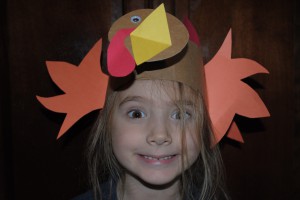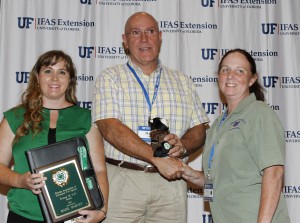by Whitney Cherry | Feb 6, 2015

Don’t let the weather ruin your club’s recreational time. Play inside!
It’s that time of year in North Florida when we’re not sure what we’ll wake up to each morning. We may be in short sleeves, sweatshirts, or hip waders and that can make planning a club meeting tough. During this time of year, between the cold and the rain, it’s seldom that our youth are allowed to go outside for PE. And in lower grades, where a gym may not be available, they are often not getting any significant amount of physical activity during the school day. This is neither good for their mental or physical health, so how can we combat the winter-blues in our club meetings? Here are a few suggestions:
Indoor relay and tag games: If space permits, move the furniture out of the way, and let the kids play freeze tag or have a relay race. Relays are often easy to relate to the educational topic of your meeting. Examples include:
- Set the table relay: where youth draw a piece of a table setting out of a paper bag, run to a table across the room, and put it in its proper place on the table. (the floor can be used in place of a table if need be.) The first team to correctly set the table wins.
- Salsa relay: youth put plastic tomatoes or peppers or onions or garlic between their knees and “run/waddle” around a cone, chair, or tape mark, at the other end of the room back to their team where they pass on their piece of food to the next team mate. The first team to have each player complete the task wins.
- Traditional balloon and ring races are always good too.
Exercise bingo: Contact your local extension office for a copy of exercise bingo. In this high intensity game, each youth or team of youth, is given a bingo card and a stack of exercise cards which face down on the floor. A teammate flips an exercise card, and each team member completes the task on the card (arm circles, pushups, jumping jacks, etc.) If their bingo card includes this exercise, the team captain marks that spot off of their card. Teammates take turn flipping exercise cards until they have Bingo. The first team to get Bingo wins.
Simon Says, Duck-Duck-Goose, London Bridge: These games require only a little space, and are still fun for younger youth, especially Cloverbuds (4-7 yrs). Simon says can often relate to your educational program as well. Ex – “Simon says comb your steer.” “Simon says, stir the batter.” “Simon says bait your hook.”
Legos, board games, etc.: It’s not very active, we know, but sometimes space just doesn’t allow for much physical activity, but it’s still important for youth to have time to interact with each other and relax. Be sure not to pick board games that may take hours to complete. Things like Charades, Guestures, Win, Lose or Draw, etc. are great options.
Now it’s your turn. Get creative, and in the comments section below, share with us the ideas you have for indoor recreation!
by Prudence Caskey | Jan 23, 2015

How Will You Make a Difference in 2015?
Let’s all take a big, deep breath…2014 is now a thing of the past! At this moment, we all have to decide what we are going to do in 2015. What will you resolve to do in the New Year? Will you finally use your elliptical for more than just a towel rack? Will you finally finish the book you were reading or that scrapbooking project? There are no limits to what you can accomplish in 2015 and in years to come.
I work with volunteers as the Santa Rosa County 4-H Agent. I know how much time it takes to volunteer and I understand the importance of my volunteers. As a very busy wife, mother, professional, graduate student, Children’s Church director and volunteer, I am often asked how I do it all. The easy answer is prioritize. The long answer is: I make lists, lots of lists! I have shopping lists, to do lists, countdown lists and lists of when my bills are due. Lists for birthdays and anniversaries. My most important list is my goal list. I write down my daily, weekly, monthly and annual goals. I break down my larger goals into smaller goals. I am a firm believer that if we can see it, we can do it!
Whatever you decide to set as a goal for 2015, I encourage you to make a difference. We all have something to offer. At the Extension Office, I meet people every day with something to offer the youth of our county. From those who have a passion for rabbits to those who love to cook and sew. On occasion, men will not offer their expertise, because they think they may not have much to offer. Believe me, showing the young people of our community how to check the oil in their cars, rotate their tires or even build a bookcase, are great life skills to pass on to our youth.
4-H volunteers are essential to help youth make the most of a wide variety of learning experiences. As a volunteer, you can share your personal interests and expertise in a variety of subjects including gardening, shooting sports, robotics, animal science, sewing/crafting, public speaking, foods and nutrition, and much more. In 4-H, you can leverage your experience and skills to help a young person find their own passions and interests.
You decide your level of involvement to fit your schedule:
- Lead youth in a community or project club, afterschool program, camp, or school group
- Serve as a chaperone, board member, judge, or camp counselor
- Develop and support service opportunities for youth to learn caring and compassion in your community
- Work with other volunteers to create fun and exciting programs to help youth in your community reach their full potential
4-H is an opportunity we wish every young person could have because research shows it is a step forward. More than 60 million of our nation’s most successful statesmen, business leaders, and scientists credit 4-H with setting them on a positive, productive path. When you share your experiences with 4-Hers, you make a difference by helping youth become caring and competent citizens. As you make goals for 2015, consider becoming a 4-H volunteer and inspire the next generation.
by Heather Kent | Dec 11, 2014
![dsc03699w[1]](https://nwdistrict.ifas.ufl.edu/4hn/files/2014/12/dsc03699w1-224x300.jpg) Cloverbuds are 4-H members between the ages of 5 and 7 and are curious, energetic and fun! Start off the new year by learning how to work with cloverbud age youth in your club. A Super Saturday Seminar will be held for any 4-H volunteer interested in learning how to teach cloverbuds on January 24th, 2015, from 10AM-3PM at Chipola College in Marianna. The training will cover a variety of topics, and each volunteer will leave with ready-to-use kits. Choose two sessions to attend:
Cloverbuds are 4-H members between the ages of 5 and 7 and are curious, energetic and fun! Start off the new year by learning how to work with cloverbud age youth in your club. A Super Saturday Seminar will be held for any 4-H volunteer interested in learning how to teach cloverbuds on January 24th, 2015, from 10AM-3PM at Chipola College in Marianna. The training will cover a variety of topics, and each volunteer will leave with ready-to-use kits. Choose two sessions to attend:
- Beach Buddies- a series of educational activities that can be done before, during and after a visit to the beach to learn science and conservation.
- Exploring Science- using popular children’s books, science experiments, and creative and recreational activities to introduce cloverbuds to scientific concepts.
- Budding Gardeners- learn how to cultivate a love of gardening and agriculture.
- Poultry and Rabbits- learn about breeds, animal nutrition, and safety.
- Visual Arts- learn how arts and crafts are similar yet different while exploring the science of visual arts.
CEUs are available for teachers. For more information, or to register, visit https://nwdistrict.ifas.ufl.edu/district-4h/super-saturday-seminars/.
by Heather Kent | Dec 5, 2014
 To support agriculture education programs and help rural America grow, Farm Credit of Northwest Florida has designed the Youth Agricultural Loan Program specifically to help active 4-H and FFA members to get a running start with their agriculture-related projects and future success. Members of these programs not only learn skills like growing crops or raising animals, but also build character traits that prepare them for a future in any career. Youth learn to set goals, plan ahead and commit themselves to completing a project they started. Farm Credit of Northwest Florida seeks to enhance the opportunities offered by 4-H and FFA by teaching their members financial well-being and further preparing them to be successful future leaders in our community.
To support agriculture education programs and help rural America grow, Farm Credit of Northwest Florida has designed the Youth Agricultural Loan Program specifically to help active 4-H and FFA members to get a running start with their agriculture-related projects and future success. Members of these programs not only learn skills like growing crops or raising animals, but also build character traits that prepare them for a future in any career. Youth learn to set goals, plan ahead and commit themselves to completing a project they started. Farm Credit of Northwest Florida seeks to enhance the opportunities offered by 4-H and FFA by teaching their members financial well-being and further preparing them to be successful future leaders in our community.
Loans will be offered for up to $2,500, will not exceed 18 months, are contingent on a purchase of cooperative stock up to $50 (two percent) of loan amount and will need to be co-signed by a parent or guardian. There are no fees involved with this program. Find more information and the application on our Young, Beginning, Small and Minority Farmers web page: http://www.farmcredit-fl.com/ybsm-farmers.html. Loan officers are available to come to your club meeting to talk about opportunities to fund youth agriculture projects. Work with your local 4-H Agent to schedule a speaker for your club.
by Heather Kent | Nov 26, 2014
 Gratitude is a tricky concept to teach children. It is essential for our happiness, but easily overlooked in the hustle and bustle of our busy everyday lives. With Thanksgiving approaching, it is a great opportunity to do an activity with your kids to help reinforce the concept of gratitude. Here are three simple ideas that you may want to incorporate into your Thanksgiving festivities (or anytime of year):
Gratitude is a tricky concept to teach children. It is essential for our happiness, but easily overlooked in the hustle and bustle of our busy everyday lives. With Thanksgiving approaching, it is a great opportunity to do an activity with your kids to help reinforce the concept of gratitude. Here are three simple ideas that you may want to incorporate into your Thanksgiving festivities (or anytime of year):
Thankfulness Tablecloth– purchase an inexpensive plain tablecloth (a muslin painter’s drop cloth is an inexpensive option). Ask family members to write what they are thankful for with a permanent marker onto the tablecloth. You can assign each family member a different color, or use a different color each year. If your children are not reading age, ask them to draw a picture of what they are thankful for. Add to the tablecloth each year.
What Would It Feel Like Without Game…Ask each member of the family to think of something they are thankful for and then ask them to describe what it would feel like if they didn’t have what they are thankful for. For example, I am thankful for a car that works and it would be hard to take my kids to school, soccer practice, and 4-H club meetings if I didn’t have a car that runs.
Gratitude Time Capsule- Ask each member of the family to write or draw something they are grateful for. Have them date and sign the slip of paper, then place the slips of paper in a mason jar. Have the kids help dig a hole in the yard to bury the jar. Do this each year and then dig up the previous year’s jar to see what has changed.
We hope you will consider adding one of these activities to your Thanksgiving traditions. Gratitude leads to Generosity, which is one of the Essential Elements youth need in order to grow up to be confident, capable citizens. Fostering a sense of generosity is just one way the 4-H volunteers and parents help youth. This time of year, 4-H Agents are especially thankful for the incredible 4-H volunteers who are making a real difference in hundreds of thousands of youths’ lives all across our state. 4-H volunteers are the core of the Florida 4-H Program and we THANK YOU for your service! For more information about 4-H, or becoming a volunteer, contact your local UF IFAS County Extension Office or visit http://florida4h.org.
by Heather Kent | Nov 21, 2014

Mark Harvey, Friend of 4-H
Mark Harvey is the manager of the North Florida Fair located at our capital city of Tallahassee. For the last thirteen years, Mark has worked diligently to promote both UF/IFAS Extension and 4-H Positive Youth Development. Mark took over as manager of the North Florida Fair after a successful 25 year career with the Tallahassee Police Department. He is husband to wife Suzanne, and they have raised four children. As manager of the North Florida Fair, he has systematically made positive changes to the fair to develop new partnerships to increase both funding and attract new audiences to the fair. One of his strategies has been to highlight the opportunities and strengths of the 4-H Positive Youth Development Program. With his background in law enforcement, he has long-been an advocate of positive youth development and understands why programs like 4-H have such high public value.
Mark’s commitment to 4-H goes far beyond the typical support of providing premiums to members and clubs for participation in exhibits and contests. In order to facilitate better exposure for the 4-H program and the UF/IFAS County Extension offices though continued expansion of still exhibits in two buildings at the fair as well as during the annual 4-H day where 4-H youth demonstrate their life skills though four different project competition areas. Mark has encouraged the 4-H Extension Faculty of the Northwest District to take advantage of the North Florida Fair as an opportunity to market 4-H and educate the public in the Tallahassee area about the value of our program. Each year, he provides up to $1,000.00 for building improvements, educational displays, new signage, and marketing materials. These funds have helped the agents develop interactive displays on the Butterfly WINGS program and 4-H gardening projects. This past year, Mark invested his own personal funds to secure the engineering exhibits from the Mary Brogan Museum. These interactive exhibits help youth and families explore basic engineering concepts such as levers, pulleys, torque, and gravity. They have drastically increased traffic into the 4-H building and pair especially well with 4-H engineering projects such as robotics. In fact, with Mark’s support, the North Florida Fair was the first regional fair to incorporate a junk drawer robotics competition during 4-H Day at the fair. To encourage participation, Mark allowed faculty to bring youth to the fair to experience the engineering exhibits and participate in a mock contest.
What I appreciate most about Mark is his accessibility and his willingness to entertain new ideas and methods. He never automatically says “no,” but considers carefully how to use our resources at the fair to educate, inspire, and make a difference in the lives of those who attend. Mark Harvey is definitely a friend to the 4-H program, and one of our biggest advocates who is helping to Make A Difference through the Florida 4-H Program.
Do you know of a 4-H volunteer or advocate that deserves the spotlight? Send your nominations to Heather Kent at hckent@ufl.edu.



![dsc03699w[1]](https://nwdistrict.ifas.ufl.edu/4hn/files/2014/12/dsc03699w1-224x300.jpg)


